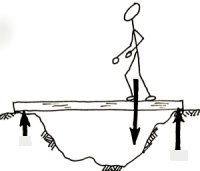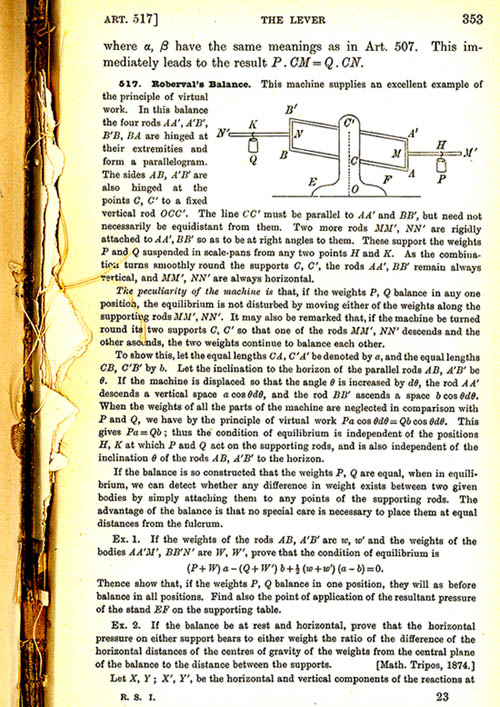John Edward Routh
Today, two textbooks. The University of Houston's College of Engineering presents this series about the machines that make our civilization run, and the people whose ingenuity created them.
 I found two books, side by side in the library -- both about statics, how forces act on bodies in equilibrium. Take a very simple example. Place a board over a ditch; then walk across it. The dirt on either side exerts upward forces. They exactly equal your weight and that of the board. As you cross the board, those two forces change; but they always add up to the same amount.
I found two books, side by side in the library -- both about statics, how forces act on bodies in equilibrium. Take a very simple example. Place a board over a ditch; then walk across it. The dirt on either side exerts upward forces. They exactly equal your weight and that of the board. As you cross the board, those two forces change; but they always add up to the same amount.
That kind of force balancing can get very tricky. Yet it's essential in designing any machine or structure -- from a simple lever to the Eiffel Tower. Still, while the library catalog places these two books together, they could hardly be more different -- one old, one new, both covering the same ground.
The 1891 book, Analytical Statics, is dense, formal, and austere -- but also clear and straightforward. The 1982 book, The Logic of Machines and Structures, is richly illustrated and has little math. It teases the mind with strange and unexpected results. It is fun. Each expands my understanding of the other, but I'm drawn to the older and dryer of the two.
Some hoodlum has ripped a whole 62-page section out of this precious old book and left it for dead. But its ruined and neglected carcass still harbors a story. It was written by an important Cambridge University mathematician, Edward John Routh.
Routh was educated at Cambridge University where he edged out James Clerk Maxwell for top honors. He almost went to work for famed Greenwich astronomer, George Airy. But then, instead, he married Airy's eldest daughter.
Routh taught at Cambridge the rest of his life. Check the Internet and you'll find many Routh theorems. Much of his important work is in use today. But Cambridge remembers his greatness as a teacher. As students presented his retirement gift, they told a story about an undergraduate who had trouble understanding the complex way we use statics to explain how bodies float in water.
He couldn't see how anything could float. The students claimed that Routh's explanation of floating was so convincing that the fellow then went away wondering how anything could ever sink.
Actually, that story suggests something of the subtleties we engineers face when we write force balances. Statics is the tool we use if we're concerned with the stability of cargo ships, the catenary shape of hanging chains, or the design of excavating shovels. Look at either of these two books and we see our civilization emerging out of its pages. Many of the same examples appear in both, yet they are framed so very differently.
The new book shows pictures of the World Trade Center, steam engines, and amusement park rides. Routh's old book shows the graceful mathematics that lets us design in three dimensions. But together they remind me that my world, which sometimes seems to be shifting under my feet, is still governed by stabilizing forces -- forces that stay constant from one generation to the next.
I'm John Lienhard, at the University of Houston, where we're interested in the way inventive minds work.
E. J. Routh, A Treatise on Analytical Statics with Numerous Examples. Vol. I, 2nd ed. (Cambridge: at the University Press, 1909) (1st ed. 1891).
P. Sandori, The Logic of Machines and Structures. (New York: John Wiley & Sons, 1982).
Routh's online biography and photo: https://en.wikipedia.org/wiki/Edward_John_Routh
My thanks to UH Colleague Lewis Wheeler for his counsel.

Above, Routh's diagram of a Roberval Balance. Below, that same image in the sad and wretched context of a book destroyed
